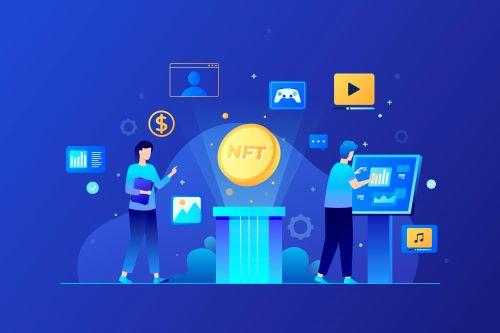
Unlicensed or manipulated picture assets in copycat coins represent a risk to less sophisticated NFT purchasers.
An NFT is a digital collectible asset, like a work of art or a trading card, that gives proof of ownership and authenticity, enabling it to be bought, sold, and collected like a Picasso at Christie's. Non-fungible tokens (NFTs) have grown in favor of the art field to prevent art theft and ensure authenticity.
NFTs are built on blockchain technology, which enables transparency, immutability, and authentication. The NFT market is fraught with fraud and scams, necessitating prudence and rigorous study by buyers and collectors. Currently stolen artwork is worth more than $6 billion, thanks to the internet age and the sharing of digital content. Due to this reason, NFT valuations can be erratic, prompting worries about investment stability and long-term viability.
Most people ask, what are the solutions for such threats? How to deploy these solutions?
Understanding The Threats
The following are some of the well-known threats identified in the NFT space.
Cybersecurity and Identity Fraud
The proliferation of NFTs has resulted in both cybersecurity issues and fraud cases. Hackers are utilizing new technology to establish phony NFT marketplaces that resemble the logos and contents of authentic ones, resulting in customers purchasing counterfeit NFTs unintentionally.
Not only does this raise copyright concerns, but it makes people vulnerable to possible fraud. Furthermore, artists have reported their work sold as NFTs without authorization. Scammers have also set up unauthorized customer care channels and social media pages impersonating reputable NFT exchanges to sell fraudulent NFTs and steal consumer information.
NFT Theft and Digital Scams
Digital works of art, frequently in the form of NFTs, have grown in popularity in the art market, posing new issues, notably in art theft and counterfeiting. The process starts with NFT creation. After creating an NFT, it's linked to a unique physical or digital item, often a URL.
Following this, purchasing an NFT entails having ownership of the URL linked with it. Unscrupulous crowds can make and sell counterfeit art by connecting them to unique URLs. Since many NFT markets do not demand artist authentication, online art thieves may easily copy, paste, mint, and sell artwork as their own. Without realizing it, buyers of NFTs may unwittingly purchase unlawfully reproduced art. Victims of art theft face additional difficulties when blackmailed by people threatening to denounce them for possessing stolen digital assets.
Wash Trading
The most common issue that new NFT enthusiasts are facing is Wash Trading. In simple terms, wash trading is when the buyer and seller in a transaction are the same people or two persons working together to boost the price of an NFT. In the NFT space, individuals can establish multiple crypto wallet addresses, enabling them to engage in self-transactions and artificially inflate the perceived value of a digital asset.
These transactions, documented on a publicly accessible blockchain, offer transparency regarding the exchange of NFTs, including the sale price and timing. However, wallet addresses remain elusive and devoid of identifiable information, appearing as enigmatic strings of alphanumeric characters. Consequently, unraveling the true identities behind transactions or establishing ownership of multiple wallet addresses becomes an insurmountable challenge.
Solutions to Tackle Threats
The following are some solutions that users can take note of to avoid such threats.
How to Identify Copycats
Without the right resources, it can be difficult for NFT enthusiasts and collectors to locate and trace the intriguing history of real NFTs within their favorite marketplace. It is easy to understand the gravity of this situation by the sheer size of NFT collections and the ongoing flood of fresh innovations!
Unlicensed or manipulated picture assets in copycat coins represent a risk to less sophisticated NFT purchasers. The value of original NFT tokens as unique collectibles is diminished by widespread copying.
To address the issue of copycat tokens in the NFT market, a variety of new AI-based tools have been developed to combat the situation. These tools make use of an image similarity model and a searchable index of important blockchain picture assets. NFT search technology identifies duplicates and modified copies of NFT picture assets for markets and stakeholders. NFT search seeks to instill trust and stability in the NFT ecosystem. The technology has the potential to boost NFT market growth.
How to tackle Wash Trading
With wash trading becoming a menace in the crypto space, NFT enthusiasts are under the threat of losing money on items that are worthless. Exchanges may combat wash trading by avoiding trading games, implementing a uniform charge schedule, enabling self-trade avoidance, and restricting traders to single institutional accounts, fostering fair and transparent trading practices.
To highlight the best practices:
- Avoid trading games that encourage manipulative behavior.
- Implementing a uniform fee schedule for all participants.
- Enabling self-trade prevention to prevent matching orders from the same account.
- Restricting traders to single institutional accounts for increased transparency.
Final Thoughts
The NFT market is still in its early stages but will continue to expand due to rising demand. Investors will earn and reap great returns in the future years. For newcomers who enter the NFT market, ensure to get the proper resources to safeguard your NFTs because the industry contains possible risks.
The author is the Founder & CEO, bitsCrunch
Image source: Freepik

 In
In
Add new comment